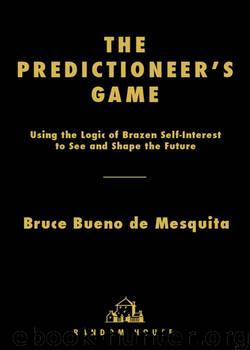The Predictioneer's Game: Using the Logic of Brazen Self-Interest to See and Shape the Future by Mesquita Bruce Bueno De

Author:Mesquita, Bruce Bueno De [Mesquita, Bruce Bueno De]
Language: eng
Format: mobi
Publisher: Random House
Published: 2009-09-28T16:00:00+00:00
INCENTIVIZING IGNORANCE
Arthur Andersen was driven out of business by an aggressive Justice Department looking for a big fish to fry for Enron’s bankruptcy. Later, on appeal, the Supreme Court unanimously threw out Andersen’s conviction, but it was too late to save the business. Thousands of innocent people lost their jobs, their pensions, and the pride they had in working for a successful, philanthropic, and innovative company. Andersen’s senior management apparently was entirely innocent of real wrongdoing. Unfortunately, they nevertheless helped foster their own demise by not erecting a good monitoring system to protect their business from the misbehavior of their audit clients. In fact, that was and is a problem with every major accounting firm. In Andersen’s case, I know from painful personal experience how needless their sad end was.
Around the year 2000, the head of Andersen’s risk management group asked me if I could develop a game-theory model that would help them anticipate the risk that some of their audit clients might commit fraud (this is where my work related to the Sarbanes-Oxley discussion from a few chapters back began). As I have related, three colleagues and I constructed a model to predict the chances that a company would falsely report its performance to shareholders and the SEC. Our game-theory approach, coupled with publicly available data, makes it possible to predict the likelihood of fraud two years in advance of its commission. We worked out a way to identify a detailed forensic accounting that helps assess the likely cause of fraud—if any—as a function of any publicly traded company’s governance structure.
We grouped companies according to the degree to which our model projected that they were at risk of committing fraud. Of all the firms we examined, 98 percent were predicted to have a near-zero risk of committing fraud. Barely 1 percent of those firms were subsequently alleged to have reported their performance fraudulently. At the other end of our scale, about 1.5 percent of companies were placed in the highest risk category based on the corporate organizational and compensation factors assessed by the model. A whopping 85 percent of that small group of companies were accused by the SEC of committing fraud within the time window investigated by the model. This is a very effective system that produces few false positives—alleging that a company would commit fraud when it apparently did not—and very few false negatives—suggesting that a company would not commit fraud when it subsequently did.
Enron was one of the 1.5 percent of companies that we highlighted as being in the highest risk category. You can see this in the table on page 119, which shows our predictions for a select group of companies that eventually were accused of very big frauds. The table shows our assessment of the risk of fraud for each company each year. The estimates of interest are for 1997-99. These assessments are based on what is called in statistics an out-of-sample test. Let me explain what that means and how it is constructed.
Suppose
Download
This site does not store any files on its server. We only index and link to content provided by other sites. Please contact the content providers to delete copyright contents if any and email us, we'll remove relevant links or contents immediately.
| Biomathematics | Differential Equations |
| Game Theory | Graph Theory |
| Linear Programming | Probability & Statistics |
| Statistics | Stochastic Modeling |
| Vector Analysis |
Modelling of Convective Heat and Mass Transfer in Rotating Flows by Igor V. Shevchuk(6392)
Weapons of Math Destruction by Cathy O'Neil(6151)
Factfulness: Ten Reasons We're Wrong About the World – and Why Things Are Better Than You Think by Hans Rosling(4696)
Descartes' Error by Antonio Damasio(3232)
A Mind For Numbers: How to Excel at Math and Science (Even If You Flunked Algebra) by Barbara Oakley(3223)
Factfulness_Ten Reasons We're Wrong About the World_and Why Things Are Better Than You Think by Hans Rosling(3199)
TCP IP by Todd Lammle(3137)
Fooled by Randomness: The Hidden Role of Chance in Life and in the Markets by Nassim Nicholas Taleb(3049)
Applied Predictive Modeling by Max Kuhn & Kjell Johnson(3019)
The Tyranny of Metrics by Jerry Z. Muller(3005)
The Book of Numbers by Peter Bentley(2913)
The Great Unknown by Marcus du Sautoy(2649)
Once Upon an Algorithm by Martin Erwig(2601)
Easy Algebra Step-by-Step by Sandra Luna McCune(2585)
Lady Luck by Kristen Ashley(2535)
Practical Guide To Principal Component Methods in R (Multivariate Analysis Book 2) by Alboukadel Kassambara(2497)
Police Exams Prep 2018-2019 by Kaplan Test Prep(2488)
All Things Reconsidered by Bill Thompson III(2358)
Linear Time-Invariant Systems, Behaviors and Modules by Ulrich Oberst & Martin Scheicher & Ingrid Scheicher(2334)
